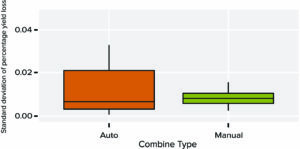Manual versus auto adjust to reduce combine loss
KEY RESULT:
Both manual adjustments and auto-adjusting features can reduce harvest losses in canola. Auto-adjusting can respond to changing environmental conditions, but should still be calibrated and ground-truthed regularly to reduce losses and optimize yield.
PROJECT TITLE, PRINCIPAL INVESTIGATOR:
“Quantifying combine auto-adjusting capabilities in canola,”
Charley Sprenger, Prairie Agricultural Machinery Institute
FUNDING:
SaskCanola, Western Grains Research Foundation
PUBLISHED ARTICLES:
Read the full report on the Canola Research Hub.
Researchers examined the impact of changing weather and crop conditions during a typical harvest day on combine losses and the performance potential of combines with auto-adjusting settings.
This research builds on a 2019 survey of canola losses in Western Canada, which identified harvest factors that impact canola harvest losses. It reported that weather conditions are a key factor influencing combine losses, and that combines should be set based on these conditions. It also noted the importance for producers to reassess their combine losses as conditions change both throughout the day and harvest season.
In the current study, researchers measured combine losses from straight cut (14 fields) and swathed canola (eight fields) for 22 combines from 13 producers throughout Saskatchewan and Manitoba. Combines included 14 different models and four different makes: Case IH, Claas, John Deere and New Holland.
Half of the combines had auto-adjusting capabilities and half required manual adjustment. Researchers used drop pans to take samples (three repetitions) at three times throughout the day. They did not provide this data to farmers during the testing. Weather conditions at the time of testing ranged between 6-27°C and the relative humidity ranged between 20-80 per cent.

Results
Key results from this experiment included:
- The average combine losses ranged from 0.1 to 10.6 bu./ac., or 0.2 to 29.4 per cent of total yield.
- As average daily temperatures increased, the variation in yield losses increased significantly. However, the variation in temperature and humidity throughout the day (from three different sample times), did not effect yield loss variation.
- There was no significant difference between swathed and straight cut operations or different ground speeds tested.
- Calendar date (ranging from September 9 to October 10) did not have a significant impact on losses.
- Interestingly, while there was no significant difference between losses in auto-adjusting and manual-adjusting capabilities, there was much less variation in the losses for the manual adjusting combine types than the auto-adjusting types.
This indicates that checking for losses is important and auto-adjusting combines still need calibration and monitoring to ensure that they are properly responding to changing conditions. Overall, combine operators need to know what is happening to make informed management decisions and any method of checking for losses is better than not checking at all.






